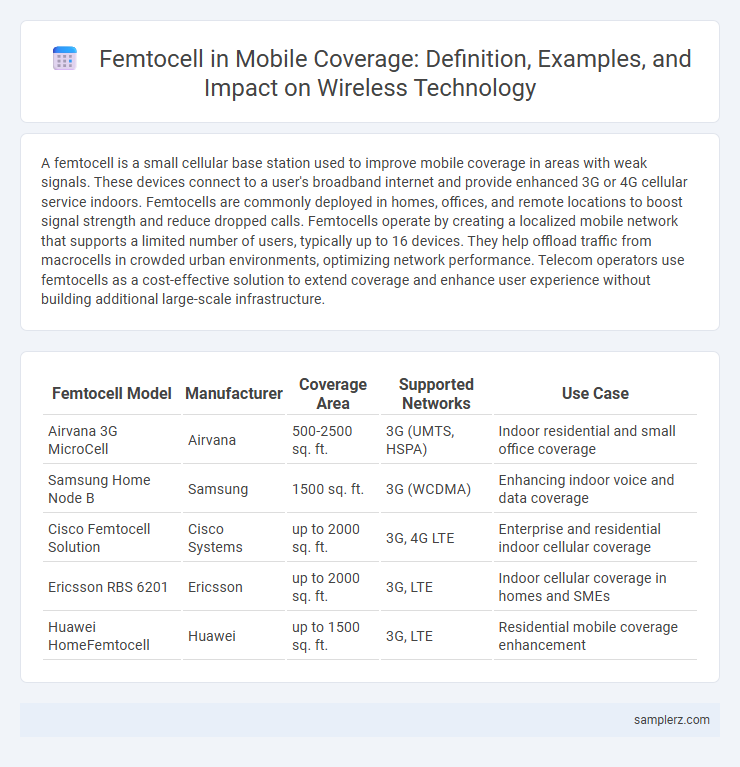A femtocell is a small cellular base station used to improve mobile coverage in areas with weak signals. These devices connect to a user's broadband internet and provide enhanced 3G or 4G cellular service indoors. Femtocells are commonly deployed in homes, offices, and remote locations to boost signal strength and reduce dropped calls. Femtocells operate by creating a localized mobile network that supports a limited number of users, typically up to 16 devices. They help offload traffic from macrocells in crowded urban environments, optimizing network performance. Telecom operators use femtocells as a cost-effective solution to extend coverage and enhance user experience without building additional large-scale infrastructure.
Table of Comparison
| Femtocell Model | Manufacturer | Coverage Area | Supported Networks | Use Case |
|---|---|---|---|---|
| Airvana 3G MicroCell | Airvana | 500-2500 sq. ft. | 3G (UMTS, HSPA) | Indoor residential and small office coverage |
| Samsung Home Node B | Samsung | 1500 sq. ft. | 3G (WCDMA) | Enhancing indoor voice and data coverage |
| Cisco Femtocell Solution | Cisco Systems | up to 2000 sq. ft. | 3G, 4G LTE | Enterprise and residential indoor cellular coverage |
| Ericsson RBS 6201 | Ericsson | up to 2000 sq. ft. | 3G, LTE | Indoor cellular coverage in homes and SMEs |
| Huawei HomeFemtocell | Huawei | up to 1500 sq. ft. | 3G, LTE | Residential mobile coverage enhancement |
Introduction to Femtocell Technology in Mobile Networks
Femtocell technology enhances mobile coverage by deploying small cellular base stations within homes or offices, improving indoor signal strength and capacity. These low-power devices connect to the mobile operator's network via broadband internet, offloading traffic from macrocells and reducing network congestion. Key benefits include better voice quality, extended battery life for devices, and seamless handover within heterogeneous networks.
Key Features and Functionality of Femtocells
Femtocells enhance mobile coverage by acting as small cellular base stations that connect to the mobile operator's network via broadband, improving indoor signal strength and capacity. Key features include low power consumption, seamless handover between macrocell and femtocell networks, and support for multiple simultaneous users within a localized range. Their functionality enables improved voice quality, reduced call drops, and extended coverage in areas with weak macrocell signals, making them essential for boosting mobile performance in homes and small businesses.
Popular Real-World Femtocell Deployments
Femtocell technology enhances mobile coverage by providing localized cellular signal improvements, particularly in densely populated areas and indoor environments. Popular real-world femtocell deployments include urban residential complexes and office buildings, where providers like Verizon and Vodafone integrate femtocells to boost 4G and 5G connectivity. This targeted deployment reduces network congestion, improves call quality, and supports seamless handoffs in cellular networks.
Leading Femtocell Solutions from Major Mobile Operators
Leading mobile operators like Verizon, Vodafone, and AT&T deploy femtocell technology to enhance indoor mobile coverage by creating small, low-power cellular base stations that connect to the operator's network via broadband. Verizon's 4G LTE femtocells improve voice quality and data speeds in areas with weak signals, while Vodafone integrates femtocells to boost connectivity in office and residential spaces. AT&T's femtocell solutions target seamless handoffs and capacity enhancement, optimizing the user experience in dense urban environments.
Practical Examples: Residential Femtocell Use Cases
Residential femtocells enhance mobile coverage by creating small cellular base stations within homes, improving signal strength for voice calls and data in areas with weak macro network reception. These devices connect to the user's broadband internet to route calls and data traffic, reducing dropped calls and boosting indoor connectivity. Major telecom operators like Verizon and AT&T deploy femtocells to support customers in rural or densely built urban homes where traditional mobile signals are inadequate.
Femtocells in Enterprise and Office Environments
Femtocells in enterprise and office environments enhance mobile coverage by providing localized cellular signals that improve voice quality and data speeds within buildings. These small cellular base stations connect to the enterprise's broadband network, reducing dead zones and offloading traffic from macrocell networks. Deployment of femtocells supports seamless connectivity for employees, boosting productivity and ensuring reliable communication indoors.
Enhancing Rural Mobile Coverage with Femtocells
Femtocells significantly enhance rural mobile coverage by providing localized cellular signal access within homes and small businesses, reducing dependence on distant macrocell towers. These small, low-power base stations improve indoor signal strength, lower call drop rates, and increase data throughput in underserved areas. Mobile carriers deploy femtocells to extend network reach efficiently, ensuring better connectivity and user experience in remote or hard-to-reach locations.
Femtocell Implementation: Case Studies from Around the World
Femtocell implementation in mobile coverage has been successfully demonstrated in countries like Japan, where SoftBank deployed femtocells to enhance indoor 3G connectivity in urban areas, resulting in improved signal strength and reduced network congestion. In the United States, AT&T's use of femtocells in residential and enterprise environments increased LTE coverage and data throughput significantly. These case studies highlight femtocells' effectiveness in addressing coverage gaps and boosting network capacity in densely populated locations.
Comparative Overview: Femtocells vs. Other Small Cell Technologies
Femtocells provide improved indoor mobile coverage by connecting to a user's broadband connection, offering distinct advantages in signal strength and reduced network congestion compared to picocells and microcells, which serve broader areas but require more complex infrastructure. Unlike distributed antenna systems (DAS), femtocells are cost-effective with easier deployment, ideal for residential or small business environments. The localized nature of femtocells delivers higher data throughput and enhanced voice quality, making them a preferred solution in enhancing mobile networks where macrocell signals are weak.
Future Trends and Innovations in Femtocell Deployment
Femtocell technology is evolving with the integration of 5G networks, enabling enhanced indoor mobile coverage and reduced latency in urban environments. Future trends highlight AI-driven self-organizing femtocells that dynamically optimize signal quality and network capacity to meet increasing data demands. Innovations also include mesh femtocell networks that improve seamless handovers and connectivity in dense smart city infrastructures.

example of femtocell in mobile coverage Infographic
 samplerz.com
samplerz.com